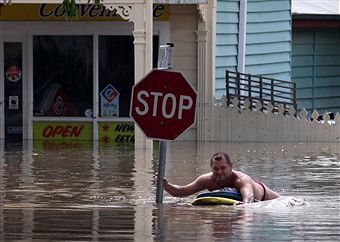 It looks like the opening of a Hollywood disaster film. The South African government has
declared parts of the country disaster areas, after 40 people died in floods in a month. At the same time, the UN is to launch an appeal for emergency flood aid for Sri Lanka, where at least 32
people have died and more than 300,000 have been displaced.
It looks like the opening of a Hollywood disaster film. The South African government has
declared parts of the country disaster areas, after 40 people died in floods in a month. At the same time, the UN is to launch an appeal for emergency flood aid for Sri Lanka, where at least 32
people have died and more than 300,000 have been displaced.
Meanwhile flood waters in Australia have left a trail of destruction, at least 18 dead and a billion dollar bill for reconstruction. And in Brazil, survivors of the floods that have killed more than 600 people are frustrated by the lack of government help.
Are these floods causes by climate change? Well, yes and no. Everyone but the most blinkered proponent – and opponent – of man-made climate change knows that individual events are meaningless and cannot be used to conclude anything about the climate. Long-term trends are what matters. As well as links between global and local events, between what is definitely man-made and what could be.
Take Australia’s floods. The reason for these lie with La Nina, the periodic ocean-atmosphere weather phenomenon that cools the eastern and central Pacific and brings wetter than usual weather. La Nina has struck before with similarly devastating effect in 1955 and 1917. But this year, La Nina has been exacerbated by record-high sea surface temperatures, and that could be a result of global warming.
The theory is that if oceans are heated by even half a degree over a forty-year period – sea surface temperatures off Queensland are apparently near record high levels – it will affect the background on which natural variabilities such as La Nina – and its opposite, El Nino – operate.
However, I deliberately say there “might” be a correlation because much remains unproven. And 2010 was in fact the coolest year in Australia since 2001 and the third wettest on record.
The floods in Brazil may tell an equally important story about the interaction between various phenomena. The rain is associated with a typical weather system in the South Atlantic. But deforestation has played a part in the damage wrought. In the past, torrential rainfall could have been soaked up by forest; now it can cause mudslides and soil erosion. In addition, rapid (and unplanned) urban development, growth in the population and construction on flood plains, have all raised the flooding risk in areas once considered flood-free.
Plenty of people will draw clear and irrefutable conclusions from today’s complex and uncertain phenomena, for or against man-made climate change. On the existing data, they would be wrong to do so, but right to be concerned.






Comments